Audio Hijack 4 Brings Interface Improvements and Recording Upgrades
Rogue Amoeba Software’s Audio Hijack 4 has arrived with significant interface improvements, new features, and enhancements. The audio-recording workflow app should be easier for existing users, smoothing and removing quirks that irked us in version 3, and faster to master for novices. Changes and additions enable better audio mastering and mixing while recording, letting you capture a live session as something close to the final version for broadcast or distribution—or maybe even good enough to upload immediately.
Audio Hijack provides a clearly expressed workflow for capturing, modifying, and outputting audio. You set up a “session” to grab audio from any source on a Mac, whether an app, mic, digitizer, or virtual audio device, and route it through “blocks,” workflow units that act upon or visualize the audio. Sessions typically end with a recording block to write processed audio to a disk file or an audio output block that sends the sound to headphones or other listening devices. You can also pipe output to supported live streaming services.
You can split blocks to send audio on multiple paths: you could record an audio stream and output both a highly compressed mono MP3 and an uncompressed AIFF file simultaneously. You can also merge paths from blocks to combine multiple audio sources into a single processing flow or recording. For audio intended to be edited later, one path might produce a merged, compact MP3 file for immediate posting, while the other records separate tracks for each speaker in a conversation as uncompressed AIFF audio files.
Audio Hijack is widely used by Mac-oriented podcasters and audio studios to capture separate mics for in-person recordings and audio channels for recordings via voice-over-IP and videoconferencing apps like FaceTime, Skype, and Zoom. Audio Hijack 4’s new features should make it even more popular.
Version 4 groups major changes into three piles: interface, new blocks, and enhancements to existing blocks. Taken together, they reduce friction and make it more of a pleasure to use the app.
Interface Changes
The previous version of Audio Hijack introduced an innovative way to connect blocks. Drag them near each other and a connection appeared to snap blocks together. Nifty—but problematic. Dragging had to be precise, and small movements could cause connection lines to be sucked from one block to another. Complicated workflows could end up with connectors ping-ponging all over the place or result in an enormous virtual space that made it impossible to see the entire workflow at once.
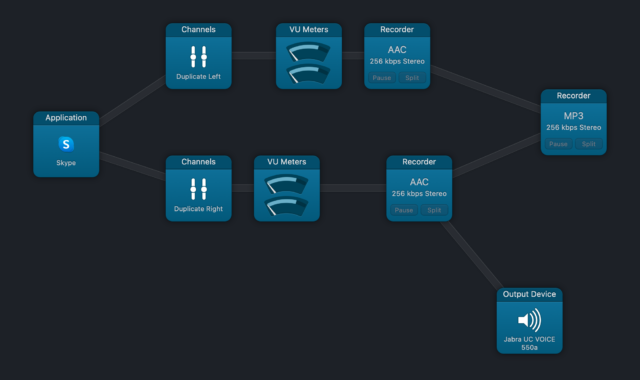
Rogue Amoeba made automatic connections an option in Audio Hijack 4. Some users may prefer them to create workflows quickly, letting the app snap linkages based on proximity as blocks are dragged. But for complicated paths, it’s now a cinch to deselect Session > Automatic Connections to disable automatic connection mode and then drag blocks into arrangements that you can parse more easily. You then connect blocks by dragging between the plus (+) signs that appear on the left and right sides of blocks.
The company also updated Audio Hijack 4’s connector style. Connections now have blue arrows that point in the direction of the flow of audio and may curve for better visualization instead of appearing as straight line segments; they’re animated and highlighted in orange while a recording session is active and a given source or connection between blocks has active audio. The new Light Mode interface option also makes it easier for many people to view blocks.
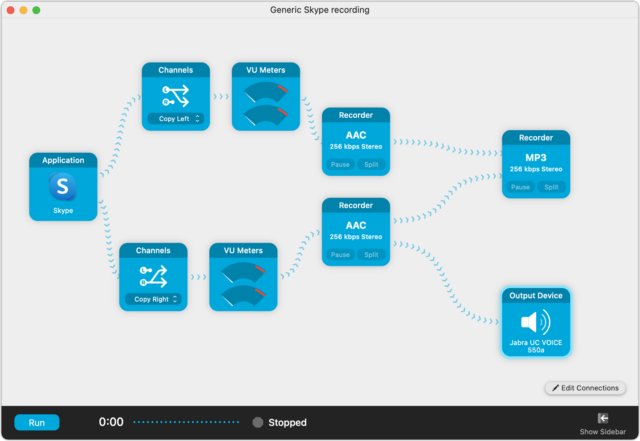
Audio Hijack 4 sports other interface improvements. The previous release used a space-occupying layout to show sessions. It’s now a much simpler, more compact list. Instead of offering a passive summary, the Session List allows monitoring and control of all sessions. Audio Hijack 4 also put most of the Session List controls into an optional system menu.
In Audio Hijack 3, it was often a chore to find recordings after you’d finished running a session, like recording a call. Each session in Audio Hijack 4 now provides a tabbed sidebar that organizes recordings, including a sound visualization preview of what was recorded, along with any scheduled times the session runs automatically, scripts (also new), and general info.
Three New Blocks
For those who record people speaking or performing, three new blocks simplify and improve setting up complicated sessions and producing audio directly from a session for live broadcast or quick posting of a file.
- Mixer: The new Mixer blocks can mix up to five sources with volume controls with presets and fades. In a multi-mic setup, having this capability entirely within Audio Hijack enables real-time balancing of sound and panning people on mono mics across a stereo space to give listeners a sense of location.
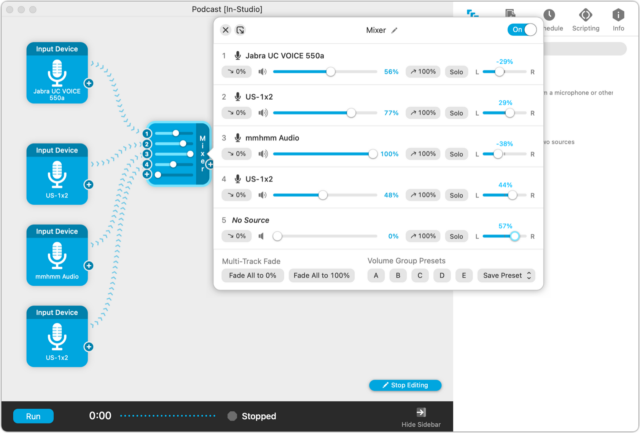
- Simple Compressor: The new Simple Compressor block provides a tailored approach to compression, the process of reducing volume differences that’s commonly used for voice recordings. Compression evens out loud and soft sounds into a narrower minimum and maximum volume range without distortion, allowing more comfortable listening at a set volume on speakers, headphones/earbuds, or in a car. Without compression, a listener may be repeatedly scrambling to adjust the volume to hear faint sounds or avoid blowing out their ears. The Simple Compressor block compresses both soft and loud sounds together, with four options to nudge the result toward a particular type of output: Music, Movie, Voice, and Radio.
- Magic Boost: Magic Boost offers a subset of compression to target a particular collection of quiet/loud improvements: many mics and some podcast guests deliver sound too quietly relative to the rest of a recording. Magic Boost “magically” compresses softer tones on one input or an input path while leaving the rest of the mix the same.
Enhanced Blocks
Rogue Amoeba has also enhanced existing blocks, mostly to make more information available on the “face” of the block—its appearance as a unit in the interface—or provide better access to its features because at-a-glance visualization is a key part of Audio Hijack’s approach. For instance, Volume Blocks that change the volume as audio passes through them now have levels on their faces, Channels show the action in inputs (like swapping left and right), and the 10-Band EQ (equalizer) reveals the positions of the sliders for each of the 10 bands that can be adjusted. An Input Switch block that allows swapping between two sources can be set as a floating palette visible across all apps. All blocks can now save and load presets, allowing reuse of settings across the app.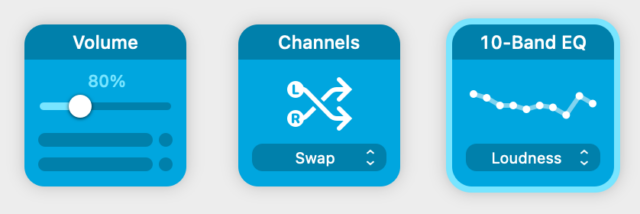
Separate from those improvements, Rogue Amoeba has finalized Audio Hijack’s previously beta Live Stream feature for sending output directly to streaming services that use the RTMP protocol—like Facebook Live, Twitch, and YouTube Live. Live Stream also now lets you set a preview video frame that can include text and images, including audio visualizations, sent with the stream.
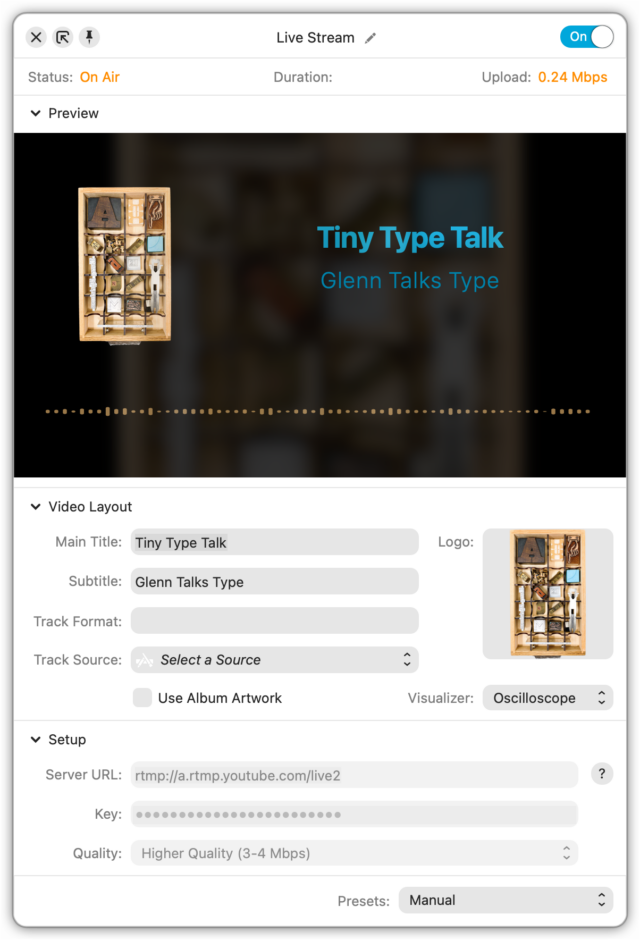
Those who use Audio Hijack heavily can set version 4 to run sessions automatically when the app launches so it’s recording or processing in the background all the time. Such people will also appreciate being able to close a session window while it continues to run, rather than having to keep it visible. And anyone who has a broader audio workflow will want to check out the new Shortcuts support in Monterey and scripting support via JavaScript. Rogue Amoeba provides a bunch of built-in scripts that are both useful in their own right and helpful for learning how to write your own scripts from scratch.
Speaking as a long-time Audio Hijack user, these improvements have proven to be a real-world boon to many of my routine activities. I expect others who work with the app will also find it a significant upgrade. But Audio Hijack 4 really shines in reducing the learning curve for new users who haven’t yet discovered the glories of taking control of their audio and funneling it in new directions.
Audio Hijack 4 costs $64 for new users or $29 for upgrades from Audio Hijack 3. You can download a trial version that lets you try all the features but adds unremovable noise after 10 minutes into an active session. If you’d like more background on using the app, you can also purchase Kirk McElhearn’s updated Take Control of Audio Hijack during checkout at Rogue Amoeba’s store.
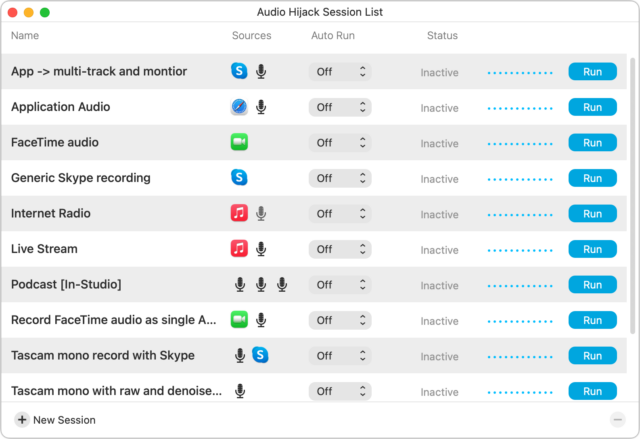
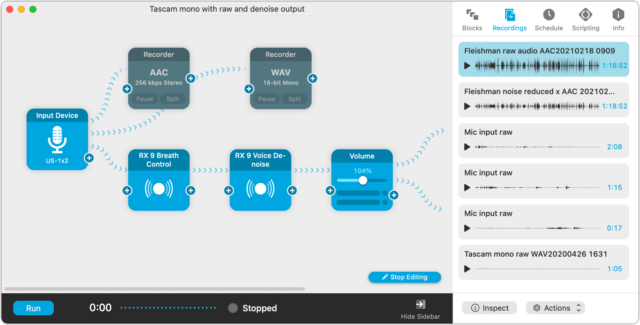
I had a problem when I upgraded to Audio Hijack 4 — my previous sessions from version 3 weren’t imported on the first launch, and trying to manually import them from within the app (via the Help menu) wasn’t working. I emailed Rogue Amoeba to ask for help, and had a conversation with Paul Kafasis over the weekend to determine where the problem was and how best to fix it. (I’d managed to workaround it by manually copying and renaming the preference lists from version 3, but Paul cautioned that it wasn’t an ideal solution, even if it did let me do a broadcast on Sunday.) Long story short, I was able to get the import to work correctly at last, and version 4.0.2 now incorporates the fix. Many thanks to Paul for his assistance (and persistance), and an example of good customer support.
Does anyone know if Audio Hijack 4 still requires that the system security level be lowered to install Rogue Amoeba’s ACE drivers?
It does. That’s always going to be a requirement, I’m afraid. They’re only lowering it to signed developer extensions, so the risk would be that a) a rogue malware operator had set up an account or hijacked an existing one b) that you were convinced to install such a system extension.
I’ve never understood what makes their extension so special that it requires one to lower the system security level (because other plugins, say from Zoom or Camo, do not). It was possible on my first M1 MacBook Pro to restore the full security level after the installation, but on my M1 Pro MacBook Pro, that resulted in an inscrutable error. I wound up removing the extension, but then I still couldn’t restore full security and had to reinstall the system!
I’ve been over this several times with RA tech support, and they have the temerity to refer me to Apple! Anyone who has dealt with Apple knows that as soon as they hear of third-party software, they ask users to remove it or refer them back to the developer!
It’s pretty straightforward: there’s no way for Rogue Amoeba to achieve what they do without it. Apple doesn’t have a way to allow specific developers to receive authorization, so Rogue Amoeba has to follow the general developer guideline, which requires you lower security for all authorized developers. (You’d think you could perhaps anoint a specific one; I’m sure they’d pay a special fee to be in a higher-scrutiny list, even.)
So if you need Rogue Amoeba’s features, they can’t do it without lower security. If Apple wanted to expose certain aspect of audio within the sandboxed full security environment, Rogue Amoeba wouldn’t need this.
Apple is more likely to listen to persistent user requests than those of developers. And they don’t listen well to users, either!